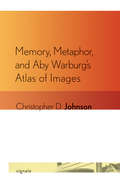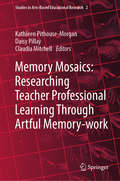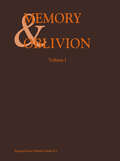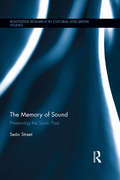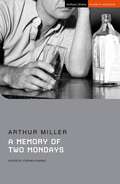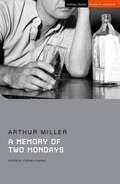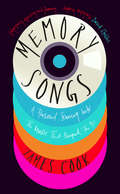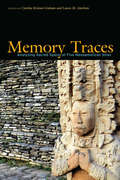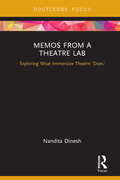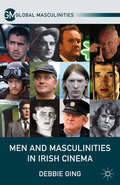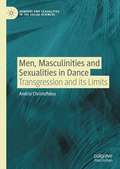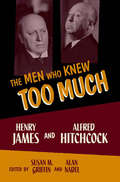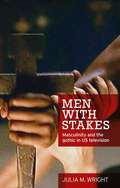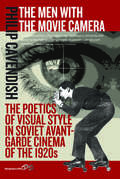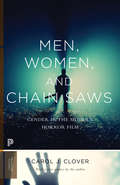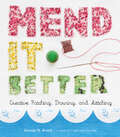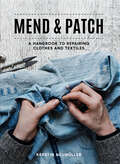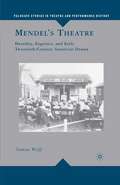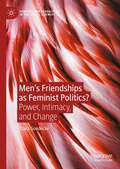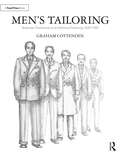- Table View
- List View
Memory, Metaphor, and Aby Warburg's Atlas of Images (Signale: Modern German Letters, Cultures, and Thought)
by Christopher D. JohnsonThe work of German cultural theorist and art historian Aby Warburg (1866–1929) has had a lasting effect on how we think about images. This book is the first in English to focus on his last project, the encyclopedic Atlas of Images: Mnemosyne. Begun in earnest in 1927, and left unfinished at the time of Warburg’s death in 1929, the Atlas consisted of sixty-three large wooden panels covered with black cloth. On these panels Warburg carefully, intuitively arranged some thousand black-and-white photographs of classical and Renaissance art objects, as well as of astrological and astronomical images ranging from ancient Babylon to Weimar Germany. Here and there, he also included maps, manuscript pages, and contemporary images taken from newspapers. Trying through these constellations of images to make visible the many polarities that fueled antiquity’s afterlife, Warburg envisioned the Atlas as a vital form of metaphoric thought.While the nondiscursive, frequently digressive character of the Atlas complicates any linear narrative of its themes and contents, Christopher D. Johnson traces several thematic sequences in the panels. By drawing on Warburg’s published and unpublished writings and by attending to Warburg’s cardinal idea that "pathos formulas" structure the West’s cultural memory, Johnson maps numerous tensions between word and image in the Atlas. In addition to examining the work itself, he considers the literary, philosophical, and intellectual-historical implications of the Atlas. As Johnson demonstrates, the Atlas is not simply the culmination of Warburg’s lifelong study of Renaissance culture but the ultimate expression of his now literal, now metaphoric search for syncretic solutions to the urgent problems posed by the history of art and culture.
Memory Mosaics: Researching Teacher Professional Learning Through Artful Memory-work (Studies In Arts-based Educational Research Ser. #2)
by Kathleen Pithouse-Morgan Daisy Pillay Claudia MitchellThis book communicates new voices, insights, and possibilities for working with the arts and memory in researching teacher professional learning. The book reveals how, through the arts, teacher-researchers can reimagine and reinvigorate moments of the past as embodied and empowering scholarly experiences. The peer-reviewed chapters were composed from juxtaposing unique “mosaic” pieces written by 21 new and emerging scholars in South Africa and Canada. Their research explores diverse arts-based practices and resources including collage, film, drawing, narrative, poetry, photography, storytelling and television alongside related ethical issues. Critically, Memory Mosaics also demonstrates how artful memory-work can engender agency in professional learning with teacher-researchers taking up pressing issues of social justice such as inclusion and decolonisation. Overall, the book offers a multidimensional, polyvocal exploration of how artful memory-work can bring about future-oriented professional learning enacted as pedagogies of reinvention and productive remembering.Memory Mosaics: Researching Teacher Professional Learning Through Artful Memory-Work, by Kathleen Pithouse-Morgan, Daisy Pillay, and Claudia Mitchell, along with teacher-researchers on two continents, is a ground-breaking book. It models a collaborative approach to arts-based research that melds memory-work, visual and poetic arts, and reflective practice to promote professional learning, personal transformation, decolonisation, and a more just future. Like colourful pebbles and bits of glass, the authors place teachers’ self-stories in relation to one another in an artful design, creating thematic coherence that evokes a deep sense of knowing. Judith C. Lapadat, Professor Emeritus, Faculty of Education, University of Lethbridge, CanadaMemory Mosaics: Researching Teacher Professional Learning Through Artful Memory-Workassembles exemplars of professional learning in an intriguing mosaic format. A topic is introduced, followed by memory-pieces; then: discussion and/or creative response. This lively juxtaposition generates momentum for highly productive forms of remembering around social justice issues, even as the reader is invited into an intimate circle of shared concern: for these issues, with these (and other) teacher-researchers. It is a beautiful, original, and practical book. Teresa Strong-Wilson, Associate Professor, Faculty of Education, McGill University, Canada
Memory & Oblivion: Proceedings of the XXIXth International Congress of the History of Art held in Amsterdam, 1–7 September 1996
by A. W. Reinink Jeroen StumpelMemory is a subject that recently has attracted many scholars and readers not only in the general historical sciences, but also in the special field of art history. However, in this book, in which more than 130 papers given at the XXIXth International Congress of the History of Art (Amsterdam) 1996 have been compiled, Memory is also juxtaposed to its counterpart, Oblivion, thus generating extra excitement in the exchange of ideas. The papers are presented in eleven sections, each of which is devoted to a different aspect of memory and oblivion, ranging from purely material aspects of preservation, to social phenomena with regard to art collecting, from the memory of the art historian to workshop practices, from art in antiquity, to the newest media, from Buddhist iconography to the Berlin Wall. The book addresses readers in the field of history, history of art and psychology.
The Memory of Sound: Preserving the Sonic Past (Routledge Research in Cultural and Media Studies)
by Seán StreetThis book explores the connections between sound and memory across all electronic media, with a particular focus on radio. Street explores our capacity to remember through sound and how we can help ourselves preserve a sense of self through the continuity of memory. In so doing, he analyzes how the brain is triggered by the memory of programs, songs, and individual sounds. He then examines the growing importance of sound archives, community radio and current research using GPS technology for the history of place, as well as the potential for developing strategies to aid Alzheimer's and dementia patients through audio memory.
The Memory of Sound: Preserving the Sonic Past (Routledge Research in Cultural and Media Studies)
by Seán StreetThis book explores the connections between sound and memory across all electronic media, with a particular focus on radio. Street explores our capacity to remember through sound and how we can help ourselves preserve a sense of self through the continuity of memory. In so doing, he analyzes how the brain is triggered by the memory of programs, songs, and individual sounds. He then examines the growing importance of sound archives, community radio and current research using GPS technology for the history of place, as well as the potential for developing strategies to aid Alzheimer's and dementia patients through audio memory.
A Memory of Two Mondays: All My Sons; Death Of A Salesman; The Crucible; A Memory Of Two Mondays; A View From The Bridge (Student Editions)
by Arthur Miller'A gentle, lyrical, Chekhovian evocation of the past, with that special unpretentious charm that special works sometimes have.'NEW YORK TIMESAt an auto-parts warehouse in Brooklyn, life seems frozen in time: as workers of every age commute in, nothing ever seems to change. Newcomer Bert, only 18 years old, hopes to escape this world, earnestly saving his wages for college… but can such a dream survive his workplace's haze of hopelessness, despondency and alcoholism?A vivid rendering of life under the Great Depression, A Memory of Two Mondays perfectly captures the anxieties and concerns of the 1930s, autobiographically reflecting Miller's own experience as an 18-year-old in this period.This Methuen Drama Student Edition is edited by Stephen Marino, with commentary and notes that explore the play's production history (including excerpts from an interview with director Rob Roznowski) as well as the dramatic, thematic and academic debates that surround it.
A Memory of Two Mondays (Student Editions)
by Arthur Miller'A gentle, lyrical, Chekhovian evocation of the past, with that special unpretentious charm that special works sometimes have.'NEW YORK TIMESAt an auto-parts warehouse in Brooklyn, life seems frozen in time: as workers of every age commute in, nothing ever seems to change. Newcomer Bert, only 18 years old, hopes to escape this world, earnestly saving his wages for college… but can such a dream survive his workplace's haze of hopelessness, despondency and alcoholism?A vivid rendering of life under the Great Depression, A Memory of Two Mondays perfectly captures the anxieties and concerns of the 1930s, autobiographically reflecting Miller's own experience as an 18-year-old in this period.This Methuen Drama Student Edition is edited by Stephen Marino, with commentary and notes that explore the play's production history (including excerpts from an interview with director Rob Roznowski) as well as the dramatic, thematic and academic debates that surround it.
Memory Songs: A Personal Journey Into The Music That Shaped The 90s
by James CookThis is the story of a music-obsessed boy’s journey from his bedroom in Hitchin to the heart of nineties London just as Britpop is about to explode... From James Cook’s early encounters with pop’s pioneers – Revolver heard for the first time, Led Zeppelin glimpsed on evening TV – through an adolescence in which friendships are forged on a mutual love for the Velvet Underground, to the high-stakes gamble of moving to the metropolis, the years between the assassination of John Lennon and Kurt Cobain’s suicide are mapped in musical memories. Along the way, we explore the diverse influences that fuelled the nineties guitar pop boom, from John Barry to Bryan Ferry, and follow James as he forms a band with his twin brother and releases a critically acclaimed debut album. More than a memoir, Memory Songs stands as a testament to music’s power over the imagination, the way it punctuates our past and shapes our future. Woven through with meditations on the artists who defined the UK's last legendary scene, it delivers a passionate analysis of the music that shaped a crucial moment in British cultural history.
Memory Traces: Analyzing Sacred Space at Five Mesoamerican Sites
by Laura M. Amrhein Cynthia Kristan-GrahamIn Memory Traces, art historians and archaeologists come together to examine the nature of sacred space in Mesoamerica. Through five well-known and important centers of political power and artistic invention in Mesoamerica—Tetitla at Teotihuacan, Tula Grande, the Mound of the Building Columns at El Tajín, the House of the Phalli at Chichén Itzá, and Tonina—contributors explore the process of recognizing and defining sacred space, how sacred spaces were viewed and used both physically and symbolically, and what theoretical approaches are most useful for art historians and archaeologists seeking to understand these places. Memory Traces acknowledges that the creation, use, abandonment, and reuse of sacred space have a strongly recursive relation to collective memory and meanings linked to the places in question and reconciles issues of continuity and discontinuity of memory in ancient Mesoamerican sacred spaces. It will be of interest to students and scholars of Mesoamerican studies and material culture, art historians, architectural historians, and cultural anthropologists. Contributors: Laura M. Amrhein, Nicholas P. Dunning, Rex Koontz, Cynthia Kristan-Graham, Matthew G. Looper, Travis Nygard, Keith M. Prufer, Matthew H. Robb, Patricia J. Sarro, Kaylee Spencer, Eric Weaver, Linnea Wren
Memos from a Theatre Lab: Exploring what immersive theatre 'does'
by Nandita DineshWhat does Immersive Theatre ‘do’? By contrasting two specific performances on the same theme – one an ‘immersive’ experience and the other a more conventional theatrical production – Nandita Dinesh explores the ways in which theatrical form impacts upon actors and audiences. An in-depth case study of her work Pinjare (Cages) sets out the ‘hows’ and ‘whys’ of her specific aesthetic framework. Memos from a Theatre Lab places Dinesh’s practical work within the context of existing analyses of Immersive Theatre, using this investigation to generate an underpinning theory of how Immersive Theatre works for its participants.
Memos from a Theatre Lab: Exploring what immersive theatre 'does' (Series In Performing Arts Ser.)
by Nandita DineshWhat does Immersive Theatre ‘do’? By contrasting two specific performances on the same theme – one an ‘immersive’ experience and the other a more conventional theatrical production – Nandita Dinesh explores the ways in which theatrical form impacts upon actors and audiences. An in-depth case study of her work Pinjare (Cages) sets out the ‘hows’ and ‘whys’ of her specific aesthetic framework. Memos from a Theatre Lab places Dinesh’s practical work within the context of existing analyses of Immersive Theatre, using this investigation to generate an underpinning theory of how Immersive Theatre works for its participants.
Men and Masculinities in Irish Cinema (Global Masculinities)
by D. GingSpanning a broad trajectory, from the New Gaelic Man of post-independence Ireland to the slick urban gangsters of contemporary productions, this study traces a significant shift from idealistic images of Irish manhood to a much more diverse and gender-politically ambiguous range of male identities on the Irish screen.
Men, Masculinities and Sexualities in Dance: Transgression and its Limits (Genders and Sexualities in the Social Sciences)
by Andria ChristofidouThis book examines men, masculinities and sexualities in Western theatrical dance, offering insights into the processes, actions and interactions that occur in dance institutions around gender-transgressive acts, and the factors that set limits to transgression. This text uses interview and observation data to analyze the conditions that encourage some boys and young men to become involved in this widely unconventional activity, and the ways through which they negotiate the gendered and sexual attachments of their professional identity. Most importantly, the book analyzes the opportunities male dancers find to develop a reflexive habitus, engage in gender transgressive acts and experiment with their sexuality. At the same time, it approaches gender and sexuality as embodied, and therefore as parts of identity that are not as easily amendable. This book will be of interest to scholars in Gender and Sexuality Studies as well as Dance and Performance Studies.
The Men Who Knew Too Much: Henry James and Alfred Hitchcock
by Susan M. Griffin Alan NadelHenry James and Alfred Hitchcock knew too much. Self-imposed exiles fully in the know, they approached American and European society as inside-outsiders, a position that afforded them a kind of double vision. Masters of their arts, manipulators of their audiences, prescient and pathbreaking in their techniques, these demanding and meticulous artists fiercely defended authorial and directorial control. Their fictions and films are obsessed with knowledge and its powers: who knows what? What is there to know? The Men Who Knew Too Much innovatively pairs these two greats, showing them to be at once classic and contemporary. Over a dozen major scholars and critics take up works by James and Hitchcock, in paired sets, to explore the often surprising ways that reading James helps us watch Hitchcock and what watching Hitchcock tells us about reading James. A wide-range of approaches offer fresh insights about spectatorship, narrative structure, and cinematic representation, as well as the relationship between technology and art, the powers of silence, sensory-and sensational-experiences, the impact of cognition, and the uncertainty of interpretation. The essays explore the avowal and disavowal of familial bonds, as well as questions of Victorian convention, female agency, and male anxiety. And they fruitfully engage issues related to patriarchy, colonialism, national, transnational, and global identities. The capacious collection, with its brilliant insights and intellectual surprises, is equally compelling in its range and cogency for James readers and film theorists, for Hitchcock fans and James scholars.
The Men Who Knew Too Much: Henry James and Alfred Hitchcock
by Alan Nadel Henry James and Alfred HitchcockHenry James and Alfred Hitchcock knew too much. Self-imposed exiles fully in the know, they approached American and European society as inside-outsiders, a position that afforded them a kind of double vision. Masters of their arts, manipulators of their audiences, prescient and pathbreaking in their techniques, these demanding and meticulous artists fiercely defended authorial and directorial control. Their fictions and films are obsessed with knowledge and its powers: who knows what? What is there to know? The Men Who Knew Too Much innovatively pairs these two greats, showing them to be at once classic and contemporary. Over a dozen major scholars and critics take up works by James and Hitchcock, in paired sets, to explore the often surprising ways that reading James helps us watch Hitchcock and what watching Hitchcock tells us about reading James. A wide-range of approaches offer fresh insights about spectatorship, narrative structure, and cinematic representation, as well as the relationship between technology and art, the powers of silence, sensory-and sensational-experiences, the impact of cognition, and the uncertainty of interpretation. The essays explore the avowal and disavowal of familial bonds, as well as questions of Victorian convention, female agency, and male anxiety. And they fruitfully engage issues related to patriarchy, colonialism, national, transnational, and global identities. The capacious collection, with its brilliant insights and intellectual surprises, is equally compelling in its range and cogency for James readers and film theorists, for Hitchcock fans and James scholars.
Men with stakes: Masculinity and the gothic in US television (PDF)
by Julia WrightMen with stakes builds on recent discussions of television Gothic by examining the ways in which the Gothic mode is deployed specifically to call into question televisual realism and, with it, conventional depictions of masculinity. Released from the mandate of realism to describe the world as it is supposed to be, television Gothic calls attention to the constructedness of gender – and therefore to the possibility of re-imagining men’s agency, authority and the legitimated forms of knowledge with which men are traditionally associated (science in particular). In this context, after an overview of Gothic television’s larger history, this study discusses in some depth seven series from the last two decades: American Gothic, Millennium, Angel, Carnivàle, Point Pleasant, Supernatural and American Horror Story.
Men with stakes: Masculinity and the gothic in US television
by Julia WrightMen with stakes builds on recent discussions of television Gothic by examining the ways in which the Gothic mode is deployed specifically to call into question televisual realism and, with it, conventional depictions of masculinity. Released from the mandate of realism to describe the world as it is supposed to be, television Gothic calls attention to the constructedness of gender – and therefore to the possibility of re-imagining men’s agency, authority and the legitimated forms of knowledge with which men are traditionally associated (science in particular). In this context, after an overview of Gothic television’s larger history, this study discusses in some depth seven series from the last two decades: American Gothic, Millennium, Angel, Carnivàle, Point Pleasant, Supernatural and American Horror Story.
The Men with the Movie Camera: The Poetics of Visual Style in Soviet Avant-Garde Cinema of the 1920s
by Philip CavendishUnlike previous studies of the Soviet avant-garde during the silent era, which have regarded the works of the period as manifestations of directorial vision, this study emphasizes the collaborative principle at the heart of avant-garde filmmaking units and draws attention to the crucial role of camera operators in creating the visual style of the films, especially on the poetics of composition and lighting. In the Soviet Union of the 1920s and early 1930s, owing to the fetishization of the camera as an embodiment of modern technology, the cameraman was an iconic figure whose creative contribution was encouraged and respected. Drawing upon the film literature of the period, Philip Cavendish describes the culture of the camera operator, charts developments in the art of camera operation, and studies the mechanics of key director-cameraman partnerships. He offers detailed analysis of Soviet avant-garde films and draws comparisons between the visual aesthetics of these works and the modernist experiments taking place in the other spheres of the visual arts.
Men, Women, and Chain Saws: Gender in the Modern Horror Film
by Carol J. CloverFrom its first publication in 1992, Men, Women, and Chain Saws has offered a groundbreaking perspective on the creativity and influence of horror cinema since the mid-1970s. Investigating the popularity of the low-budget tradition, Carol Clover looks in particular at slasher, occult, and rape-revenge films. Although such movies have been traditionally understood as offering only sadistic pleasures to their mostly male audiences, Clover demonstrates that they align spectators not with the male tormentor, but with the females tormented—notably the slasher movie's "final girls"—as they endure fear and degradation before rising to save themselves. The lesson was not lost on the mainstream industry, which was soon turning out the formula in well-made thrillers.Including a new preface by the author, this Princeton Classics edition is a definitive work that has found an avid readership from students of film theory to major Hollywood filmmakers.
Mend It Better: Creative Patching, Darning, and Stitching
by Kristin M. RoachWelcome to the new face of mending! Don&’t hide patches — make them into bold, beautiful embellishments. Repair holes with colorful thread and a creative darning stitch, or use fun embroidery to bring new life to a stained shirt. With detailed step-by-step photography, Kristin Roach teaches you a wide range of patching, darning, and repair stitches using both hand and machine sewing. Revive your wardrobe with these traditional mending techniques to make worn-out clothing not just wearable, but better than ever.
Mend & Patch: A Handbook To Repairing Clothes And Textiles
by Kerstin NeumüllerWith this guide to mending and patching, you don’t have to say goodbye to your worn favourite clothes.
Mendel’s Theatre: Heredity, Eugenics, and Early Twentieth-Century American Drama (Palgrave Studies in Theatre and Performance History)
by T. WolffMendel's Theatre offers a new way of thinking about early twentieth-century American drama by uncovering the rich convergence of heredity theory, the American eugenics movement, and innovative modern drama from the 1890s to 1930.
Men’s Friendships as Feminist Politics?: Power, Intimacy, and Change (Genders and Sexualities in the Social Sciences)
by Klara GoedeckeThis book discusses men’s friendships in relation to queer, discursive, and intersectional feminist theories. It analyses stories of intimacy, touch, hugs, and conversations, connecting these with current discussions within feminism and critical masculinity studies on “new” men, men’s political activism, and how friendships are lived and conceptualised in relation to heteronormative relationship ideals. Drawing on individual and dyadic interviews with middle-class Swedish men, all engaged in or sympathetic to feminist issues in some sense, this volume shows that Swedish gender equality ideologies as well as feminist, therapeutic, neo-liberal, and individualist discourses prevalent in the Western world structured the men’s friendships and their engagement with gender politics. Chapters cover friendship temporalities, gendered friendship ideals, friendship as men’s politics, and friendship as performed in interaction. Bridging the literatures of feminist research and friendship, the author points to tensions and contradictions in pro-feminist men’s political projects and in contemporary masculine positions.
Men's Tailoring: Bespoke, Theatrical and Historical Tailoring 1830-1950
by Graham CottendenMen’s Tailoring: Bespoke, Theatrical and Historical Tailoring 1830-1950 introduces the reader to English tailoring and covers the drafting of patterns, cutting out in cloth, and the complete traditional construction techniques in sequence for the tailoring of a waistcoat, trousers and jacket. The book contains: step-by-step instructions, complete with illustrations, for students and costumiers who are new to the making of male tailored garments from the nineteenth and twentieth centuries; drafting blocks and construction techniques for the main three styles of nineteenth century male garments: frock coat, morning coat and dress coat; patterns, photographs and detailed measurements taken from a variety of male coats, jackets, waistcoats and trousers from c1830 - c1950 from museums and collections. From choosing the right cloth to preparing for the fitting process, this how-to guide will help readers create beautiful, historically accurate three-piece suits for events and performances.
